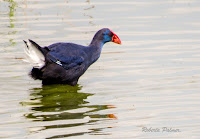WESTERN SWAMPHEN
WESTERN SWAMPHEN (Porphyrio porphyrio) – (See images below)
DESCRIPTION: The Western Swampen upper parts are mainly charcoal and under parts are shiny dark blue-purple. Tail is short and undertail is white. Eyes, strong bill and frontal shield are red. Long legs and feet are red-orange. Sexes are similar. Bird length is about 50 cm (18 inches). There are many subspecies.
VOICE: https://www.xeno-canto.org/species/Porphyrio-porphyrio
NAME: ‘Swamphen’ refers to the bird’s habitat and its legs and feet anatomy, similar to those of chickens. Latin genus and species name ‘Porphyrio’ means ‘purple water hen’. Also called ‘Purple Swamphen’.
HABITAT: Wetland edges such as swamps, streams and marshes.
DIET: Shoots of reeds, amphibians, snails. Will also steal eggs and prey on ducklings. When feeding, this species will use its foot to bring food to its bill.
NESTING: Nest is a floating platform made of aquatic plants and hidden in thick emergent vegetation. Around four yellowish to reddish eggs are laid, incubated by both parents. Chicks fed by both parents.
DISTRIBUTION: Main year-round range is in Spain and other countries on both sides of the Mediterranean.
Distribution Map: http://s1.sovon.nl/ebcc/eoa/?species1=&species2=&species3=&species4=4270
CONSERVATION: Population widespread, currently not at risk. Protected species in most of its range, but threats exist, such as illegal hunting, habitat loss from wetland drainage, and poisoning from pesticides. Can cause damage in rice paddies.
NOTES: Swamphens are part of the Rail family. This one species flies well in spite of its bulky appearance, with its legs dangling. It also swims well in spite of not having webbed feet.
SIMILAR SPECIES: Common Gallinule, Purple Gallinule, Pukeko
REFERENCES: https://en.wikipedia.org/wiki/Western_swamphen
https://www.vogelwarte.ch/en/birds/birds-of-switzerland/western-swamphen
http://www.oiseaux-birds.com/card-purple-swamphen.html (porphyrio porphyrio)
DESCRIPTION: The Western Swampen upper parts are mainly charcoal and under parts are shiny dark blue-purple. Tail is short and undertail is white. Eyes, strong bill and frontal shield are red. Long legs and feet are red-orange. Sexes are similar. Bird length is about 50 cm (18 inches). There are many subspecies.
VOICE: https://www.xeno-canto.org/species/Porphyrio-porphyrio
NAME: ‘Swamphen’ refers to the bird’s habitat and its legs and feet anatomy, similar to those of chickens. Latin genus and species name ‘Porphyrio’ means ‘purple water hen’. Also called ‘Purple Swamphen’.
HABITAT: Wetland edges such as swamps, streams and marshes.
DIET: Shoots of reeds, amphibians, snails. Will also steal eggs and prey on ducklings. When feeding, this species will use its foot to bring food to its bill.
NESTING: Nest is a floating platform made of aquatic plants and hidden in thick emergent vegetation. Around four yellowish to reddish eggs are laid, incubated by both parents. Chicks fed by both parents.
DISTRIBUTION: Main year-round range is in Spain and other countries on both sides of the Mediterranean.
Distribution Map: http://s1.sovon.nl/ebcc/eoa/?species1=&species2=&species3=&species4=4270
CONSERVATION: Population widespread, currently not at risk. Protected species in most of its range, but threats exist, such as illegal hunting, habitat loss from wetland drainage, and poisoning from pesticides. Can cause damage in rice paddies.
NOTES: Swamphens are part of the Rail family. This one species flies well in spite of its bulky appearance, with its legs dangling. It also swims well in spite of not having webbed feet.
SIMILAR SPECIES: Common Gallinule, Purple Gallinule, Pukeko
REFERENCES: https://en.wikipedia.org/wiki/Western_swamphen
https://www.vogelwarte.ch/en/birds/birds-of-switzerland/western-swamphen
http://www.oiseaux-birds.com/card-purple-swamphen.html (porphyrio porphyrio)
 |
| Western swamphen, by Roberta Palmer |